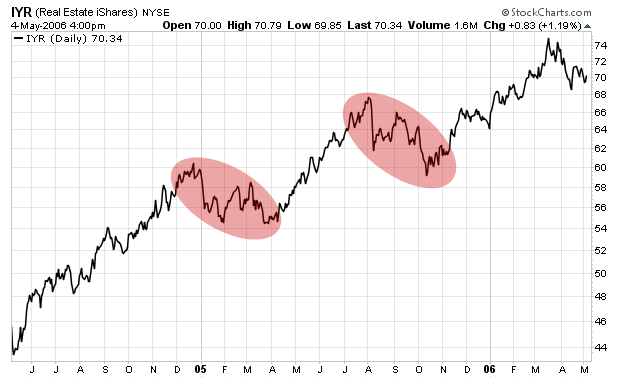| Home | About Us | Resources | Archive | Free Reports | Market Window |
Investment ConsiderationsBy
Saturday, May 6, 2006
In recent times, we have made the case for selling U.S. bonds and buying precious metals and real-estate-related equities in Asia. From a near term perspective, I am becoming uncomfortable with most asset classes as speculation is rampant everywhere. Bulletin Board volume has exploded, art prices are soaring, and the Vietnam Stock Exchange Index is up over 60% since the beginning of the year! Everybody is bullish about something, and the more remote an investment opportunity is located and the more obscure it is, the more investors are willing to embrace it. It is hardly an environment from where major upward price moves begin! In fact, I think we are at the tail end of a buying panic that could be followed by a surprisingly sharp correction or downturn, as some cracks have begun to emerge. The Middle Eastern stock markets, which were the leaders of the last three years, have all caved in. In the Baltic and in Eastern Europe, several stock markets have also begun to weaken. The Russian stock market looks as if it could break down. Then, there are high-yielding currencies, which were strong over the last few years but now, also, look vulnerable. In the U.S., it finally looks as if the housing industry is rolling over. Another crack in the Goldilocks scenario is the bond market. As mentioned above, since 2002, all asset classes have increased in value. However, recently bonds have started to break down (interest rates to go up). From a longer-term perspective, I remain extremely negative about U.S. long-term bonds. But, near term, I envision the following scenario: Right now, risk appetite is at an extreme and everybody is bullish about something. Investors are also extremely optimistic about the global economy. Hence the significant rise in commodity prices. However, given tighter international liquidity and weakness in U.S. housing, and the potential for equity markets to undergo a nasty correction in the next three to six months, the global economy could — for a change, after having surprised on the upside for the last three years — disappoint. If such a scenario were to play out, U.S. bonds could rebound, while industrial commodities and precious metals could sell off. Therefore, short bond positions should be covered, and traders might consider buying ten-year treasuries at yields above 4.80%. (I am hiding in two-year bonds.) While precious metals remain my favorite asset class, I am concerned about excess speculation in this market as well. Moreover, investors shouldn’t forget that within long-term bull markets huge corrections can occur. In the great bull market of the 1970s, which in 20 years will look like a minuscule rise courtesy of the U.S. Fed, a severe correction took place between December 31, 1974 and the end of August 1976. Gold prices fell by almost 50%. But then gold rallied another eight-fold to its January 1980 peak! Finally, as explained in last month’s report, the technical position of asset markets has deteriorated. Some markets are grossly overbought and dominated by euphoric speculation, while others have lost momentum. In the US, the Dow Jones Utilities Average peaked out in July 2005 and the Nasdaq 100 in January of this year. Selling pressure has been on the rise, while buying power has diminished. Finally, for investors who must own equities Asia offers probably the best value. Asia ex- Japan has continued to under-perform the global emerging market universe, and within Asia markets such as Taiwan, Malaysia, and Thailand have underperformed Asia. These stock markets, with their high dividend yields, would seem to have far less downside risk in a downturn than other more extended and overbought asset markets around the world. Good Investing, Marc Faber Editor’s Note: Since 1973, Dr. Marc Faber has lived in Hong Kong. In June 1990, Dr. Faber stepped down from his position as Managing Director at Drexel Burnham Lambert (HK) Ltd. And he set up his own business, MARC FABER LIMITED, which acts as an investment advisor and fund manager. Dr Faber publishes a widely read monthly investment newsletter The Gloom, Boom & Doom Report which highlights unusual investment opportunities, and is the author of several books including TOMORROW'S GOLD – Asia's Age of Discovery first published in 2002. Dr. Faber is also a regular contributor to several leading financial publications around the world and a well-known speaker at investment seminars. He is associated with a variety of funds and is a member of the Board of Directors of numerous companies. Dr Marc Faber was born in Zurich, Switzerland. Learn more about The Gloom, Boom and Doom Report here. Market NotesIS THE TOP FINALLY IN FOR REITS?
After a huge bull run during the past few years, Real Estate Investment Trusts (REITs) are struggling to make new highs. For a glance at the REIT market, our chart of the week is the iShares U.S. Real Estate Index Fund (IYR). This ETF tracks the general conditions of the REIT industry, good or bad. IYR is well off its April 2006 high. REITs have suffered similar declines in the past few years (shaded red). They were just blips on the screen, however, as REITs recovered to new highs. But this decline comes with a stern warning… we quote the brilliant Leuthold Group in a recent report on REIT stocks: “For the year to date, our REIT Index is already up 14.9%. Based on our analysis, however, REITs are extremely overvalued and ultimately expected to move significantly lower.” Consider Leuthold’s warning. With the rich valuations REITs carry, this small correction could turn into something worse… Let us know what you think the future holds for REITs by emailing us at: [email protected] -Brian Hunt |
Recent Articles
|


